Each problem is a Raven Matrix type puzzle – a type of IQ problem that measures fluid intelligence which is your reasoning and problem solving ability in new situations. Working through these problems can help with how to do a Raven test.
Practice on these questions can also help with Mensa requirements for the ‘culture fair test battery’. Click here for a useful tutorial on What is Mensa?
Let the matrix reasoning problems begin….
1.
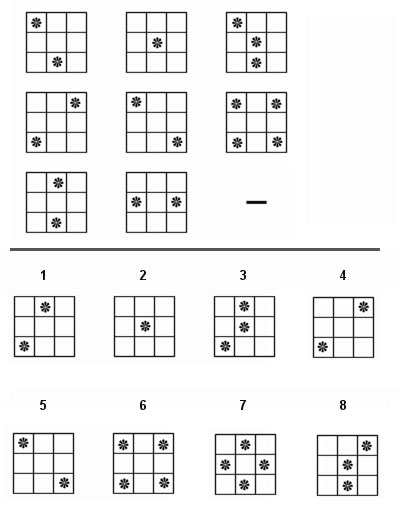
Matrix Reasoning problems are one of the best ways to measure our fluid intelligence. The famous ‘Ravens Matrices’ IQ test (standard and advanced) – which Mensa accepts as a qualifying IQ test – are made up of ONLY matrix reasoning problems. All IQ tests have a section for these types of problems. This problem set is from Bergman Data and Smartkits.com.
These types of problems are often used in job aptitude (psychometric) tests.
Try to complete all problems in half an hour. Most of these types of questions have time limits, so it is advised to work through them with a sense of limited time. If one is taking time, skip it and return to it later. They tend to get more difficult as they go along. Getting practice in these problems will help your performance in any IQ test. If you get 6-9 correct you have a chance at Mensa with some training; if you get 10-12, you should not struggle with the Mensa challenge.
There has been a change in some of these questions, to get a more representative variety of questions! If you were working on the older set, I can provide answers for those too!
ARE YOU READY?…
2.

3.
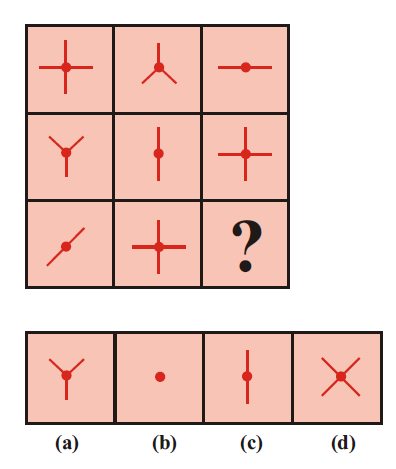
4.

5.

6. What figure should come next (after e)?

7.
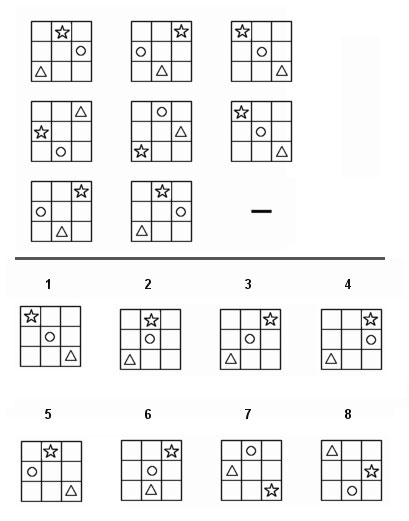
8.

9.
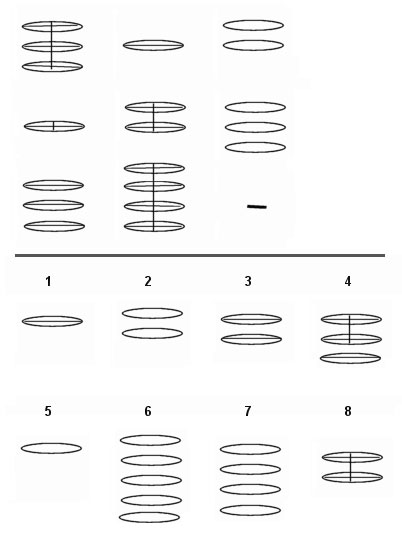
10. Which one is NOT part of the series?
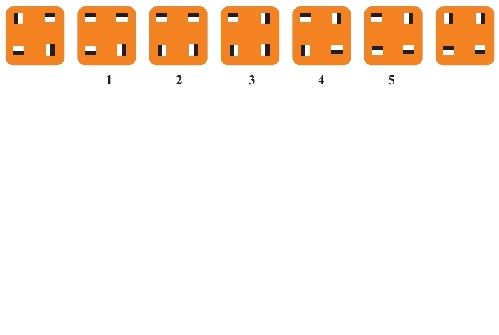
11.
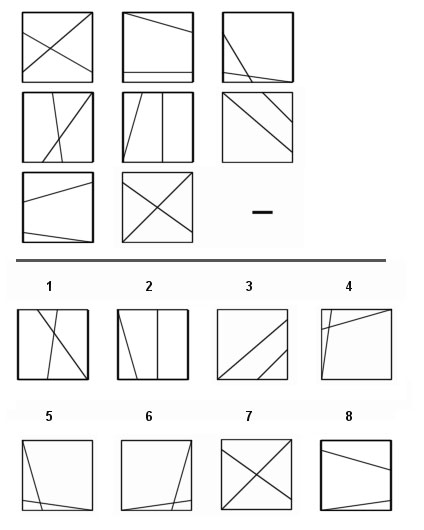
12.
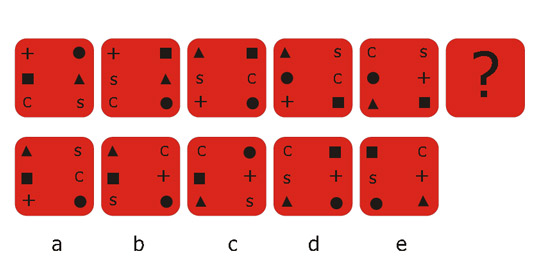
Answers for the Matrix problems
1. 7, 2. D, 3. A, 4. D, 5. A, 6. 1, 7. 1, 8. B, 9. 5, 10. 1 OR 5 (did anyone spot this?). 11. 5, 12. C.
Note that with 10, you may have found an answer, and assumed this was the only answer, but two answers are in fact possible.
You can see explanations for most of these answers here.
Solving these kinds of problems requires finding underlying rules. Here is an example from a famous IQ test called Raven Advanced Progressive Matrices:
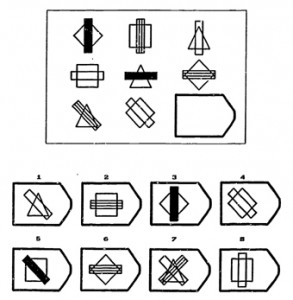
1. Each row contains 3 shapes (triangle, square, diamond).
2. Each row has 3 bars (black, striped, clear).
3. The orientation of each bar is the same within a row, but varies from row to row (vertical, horizontal, diagonal).
From these 3 rules, the answer can be inferred (5).

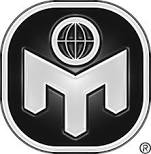

d, a, d, a, 1, 1, b, 5, 1, 5, d
in 11 absolute guess
Got 11 right though..But forgot to check time
[…] Answers for the Matrix problems in this post. […]
Only 9 right in 10 minutes…
Ones I got wrong were; 4 9 and 11.
However I’m still absolutely sure 4 is an unfair question since color blind people would not be fooled by it
I guessed 11 and 9.
10. 1 OR 5 (did anyone spot this?)
I found something rather interesting for this one. The sequence I used only allows #1 to be eliminated though. https://img521.imageshack.us/img521/6783/96066203.jpg
#4 is unfair. The answer is to put the center piece on the outside, inscribe within the leftmost piece and then inscribe the center piece inside the leftmost piece. All three pieces have different colors. In the answer key you can have either the colors right or the pattern right, but not both. We are then left to guess which one is more important.
This test was easy. #4 was perfectly fair. You just have to look at the number of lines per square. You looked to far into it. I got 12 out of 12 right. and did it in 8.42 minutes. This was fun though.
This test was fairly challenging i got 12 out of 12 took like 6 min
I got 10 of 12 correct. I still don’t understand questions #9 & #11. what is the underlying pattern in each? can someone please post explanations? thanks
1.7
2.d
3.a
4.d
5.a
6.?
7.1
8.b
9 ?
10.2
11.?
12.c
Who can explain me the result of 11th matrix?
10/12. 10 minutes. With 30 minutes, I’m assuming if we took the entire time, some of us would have gotten them all. Not too hard at all.
To the person who asked, I got 9 right, and I did 5 because they cancel each other out.. The first one has 3 connected by a line..one by itself..that equals one blank one..second line has 3 connected by lines..so it equals 3 blank ones..3rd..4-3=1 idk if that’s right, but it happened to give me the right answer
hello
thank you for iq test .
answer:
1.7 2.d 3.a 4.d 5.a 6.5 7.1 8.b 9.1 10.2 11.2 12.c
good bye.
10 and 11 no idea
The rest in five minutes
I think 11 i completely outside my abilities to solve it
Was interested to see 11. Answered correctly (5) – 1:30 min. If you see the first line – the lines are “lined” – the lines in second square start from the same level as the end of the lines in 1st, then the same thing for the third square. Second row – the same idea, but from the top to bottom (try to place one on another). Then, logically, when you see the third row – lines in cube 1 end and in 2 start at the same point…then there is only 1 square which meets this requirement.
Sorry for mistakes, English is not my native.
Had to come back and finish – all 12 correct 15 min. total.
Very cool site, thank you!
Seems like all the comments are supposed geniuses , anyhow I struggled with the first two questions went on to 3+ and found them easy till about question 7.I went back to the first two and couldn’t fully figure them out, I guessed and turned out I was right, most likely I was on to something but just couldn’t fully complete the patterns. I guess your brain has to take time to get into puzzle solving mode, or at least mine dose.
I skipped ahead to question 11 and surprisingly was able to partially figure it out. I wasn’t able to get it right but saw part of the solution.After that I figured half an hour had gone by so in total I got 6 right.
I’m assuming 6 right = 115 IQ since you said with training it might be possible to join Mensa and you gain 10-20 IQ points with IQ pro , 10 right = 130 IQ and getting all 12 = 140 IQ +?
Regarding #9:
Circles with + in them can be regarded as positive numbers.
Circles with “blank” inside can be regarded as positive numbers.
Circles with – in them can be regarded as negative numbers.
Meaning this:
[+3] [-2] = [+1]
[+1] [+2] = [+3]
[-3] [+4] = [??] = [+1]
And since [+1] equals either a circle with a + inside or “blank” inside, FIgure 5 got to be the only answer.
Each figure may be regaded like this:
1 3
2 4
And for each new picture them numbers 1,2,3,4 flips in turn.
The sequence goes like this:
First: Unchanged
1: #1 changes
2: #2 changes
3: #3 changes
4: #4 changes
5: #2 changes (and this is wring since it’s now #1 which should have changed.)
Last: #1 changes
*the **wrong
sorry for bad spelling
On 9 why 5 an not 2 ?
In first column are 7 , in column (2 )are 7 and in column (3) are 6 if you chose answer 5. If chose answer 2 then are 7.
10: I would say that nr 3 is the answer. The moving piece is crossing over the board from nr2 in a diagonal way.
Why do you guys say the right answer is 2, symetric?
Question6: I think 3 is also a possible answer , because you can overlap the images ( presuming they are transparent and the + and = are opaque) and notice that + form a shape( there are 2 on the right part of the upper side of the square, 2 on the right part of the down side and there could be 2 on the down part of the left side if we choose the 3rd answer ) .The same thing with the = signs except that the free side is the left one. Is that correct?
answer to question 6 is 1
Can anyone please explain the 11th matrix?
Follow the line positions from box to box, as though the two lines were continuous.
9 of 12 in 10 minutes > time limits that are applied?
Matrix reasoning highest score on Wechsler test.
DX Asp traits: Higher score likely on Raven’s matrices.
11 correct = Shapes had been dragged to central position, revealing form to come (look to top left vs bottom-mid & top-mid vs bottom-left).
IMHO (and in support of others who answered 2.) question 10 is flawed.
If you apply the rule that one symbol rotates clockwise on each step and then the rule is to move clockwise to the next symbol around the square i.e.:
1 2
4 3
step 1 sees symbol #1 turn clockwise
step 3 sees symbol #2 turn clockwise (the next symbol moving clockwise around the square)
step 4 sees symbol #3 turn clockwise
step 5 sees symbol #4 turn clockwise
the final step sees symbol # 1 move again.
Step 2 is the odd one out.
Ignore the above, i’ve just noticed that two symbols move from the intial step so it can’t be step 2 that’s wrong, but that would mean it also can’t be step 1, it can only be step 5.
Can someone explain 12 to me.
I also have the same doubt
#6 I can see why 1 maybe the right answer, but not sure of my logic? In the 6 blocks including the answer block, the + is in the same row only twice. Thus only 1 or 2 could be right. The relationship between the + and = goes from 3 to 2 moves apart on successive blocks. Thus, on the answer block they must be 2 moves apart (one over and one down).thus 1 would be right. There must be a simpler logic for the right solution. What is it?
After a struggle on some of the others I got them right without looking at the answers, but it took about two hours.
Wow, Inna, that is a very simple and smart solution. My rule was to to
average the vertical side of the piece wise intersections, then flip the frontal and bottom ends of the line, then lastly, vertically rotate the object and swap sides of the triangle.
They both move counterclockwise alternating between moving 1 or 2 positions.
I think 2, 5 and 6 answers all are adequate for the question 9.
can you help me how I can solve solve the 11 number matrix problem?????
I don’t believe the picture of #4’s solution is correct.
The way I see it, the mid box is the outermost layer, the left shape is the middle layer, and the shape on the inside is the shape of the mid box and the leftover color not used yet.
If my guess is true, then the answer should be a Yellow Triangle-> Green Square-> Red Triangle, working your way to the center.